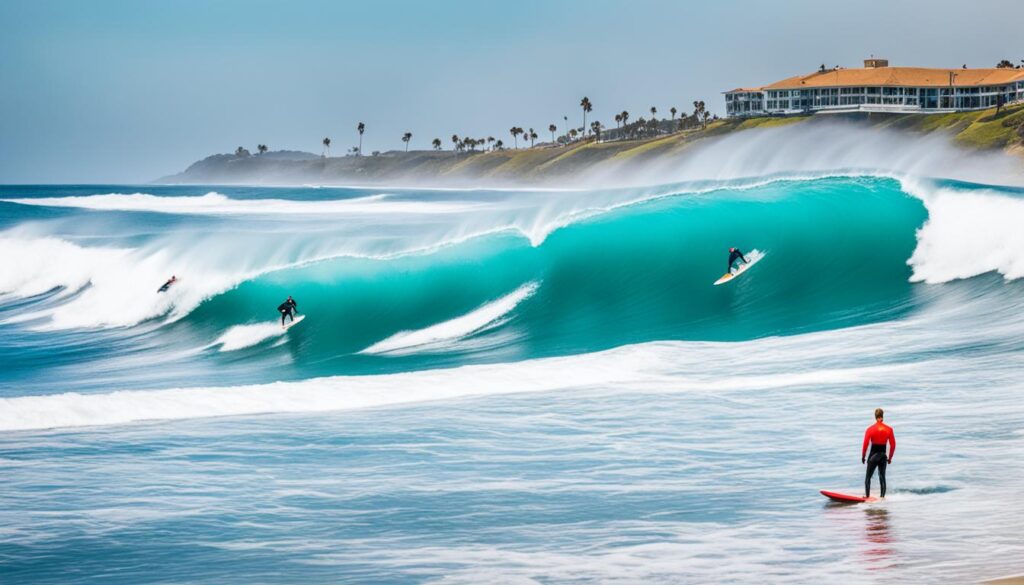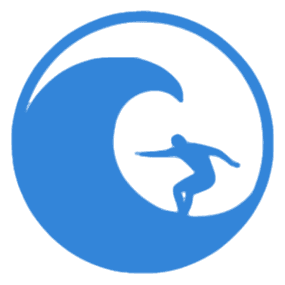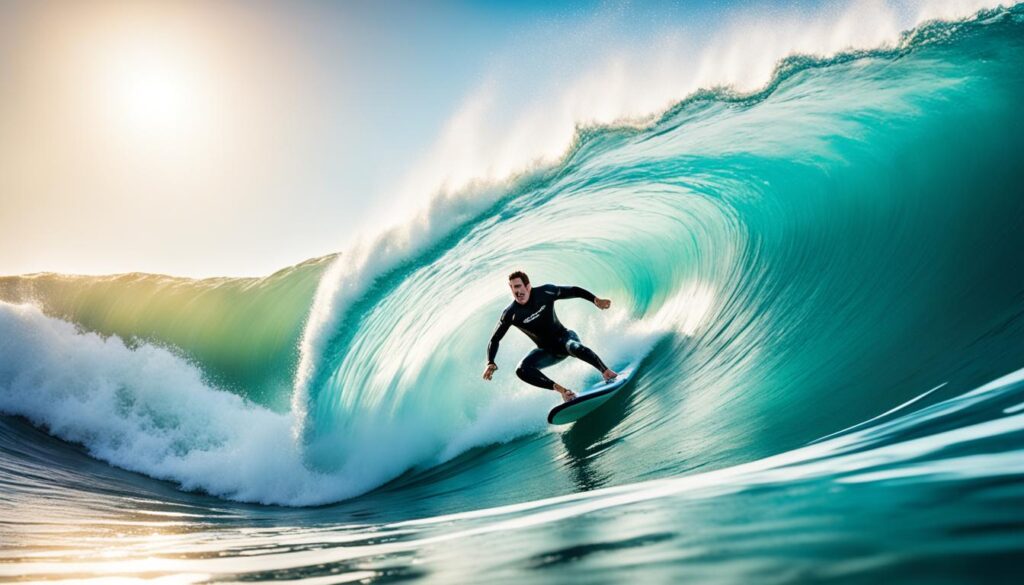Have you ever wondered about the differences between surfing and bodyboarding? Is one sport superior to the other? Let’s dive into the exhilarating world of wave riding and explore the unique characteristics of these two popular water sports.
Surfing and bodyboarding may seem similar at first glance, but they have distinct features that set them apart. From the type of board used to the riding techniques employed, each sport offers a different experience on the waves. So, which sport suits you best? Let’s find out!
Key Takeaways:
- Surfing and bodyboarding are both exciting water sports that offer unique wave riding experiences.
- The choice between surfing and bodyboarding depends on individual preferences and desired challenges.
- The type of board, riding techniques, wave preferences, skill requirements, cost, and accessibility vary between surfing and bodyboarding.
- Surfing provides fitness benefits, a variety of board options, and the opportunity to enjoy good waves.
- Bodyboarding is accessible to people of all ages, offers stability in the water, and serves as a stepping stone towards surfing.
Origins and Rivalry
Both surfing and bodyboarding have ancient origins in the Hawaiian Islands and have gained worldwide popularity over the years. The roots of surfing can be traced back centuries ago when Polynesians first navigated the powerful waves of the Pacific Ocean using wooden boards. On the other hand, bodyboarding, also known as boogie boarding, has its origins in the innovative spirit of Tom Morey, who designed the first commercial bodyboard in the 1970s.
As these two water sports gained recognition, a rivalry between surfers and bodyboarders began to emerge. Surfing was traditionally seen as the pinnacle of wave riding, celebrated for its grace, skill, and deep connection to the ocean. In contrast, bodyboarding was often regarded as a more accessible and fun alternative, attracting individuals seeking a different wave-riding experience.
This rivalry has given rise to debates and clashes between surfers and bodyboarders, each group fiercely defending their preferred sport. Surfing enthusiasts argue that the act of riding a wave while standing up requires a higher degree of skill and provides a more rewarding experience. Meanwhile, bodyboarders emphasize the maneuverability and versatility of their boards, showcasing a unique way to connect with the waves while lying down or on their knees.
“Surfing and bodyboarding are both incredible sports that offer a thrilling experience in the water. It’s natural for a sense of rivalry to emerge, but it’s important to remember that both sports bring joy and excitement to their respective communities.” – Kelly Slater
This ongoing rivalry has not only fueled healthy competition but has also contributed to the progression and innovation of both sports. Surfers and bodyboarders continue to push the boundaries of what’s possible, inspiring each other to explore new techniques, maneuvers, and board designs.
Ultimately, the choice between surfing and bodyboarding is a matter of personal preference and the type of wave-riding experience one seeks. Whether you prefer the traditional elegance of surfing or the dynamic thrill of bodyboarding, both sports offer a unique connection with the ocean and the opportunity to create unforgettable memories.
Board Differences
One of the main differences between surfboards and bodyboards lies in the characteristics of each board. These differences greatly impact the riding experience and the preferences of surfers and bodyboarders alike.
Surfboards:
Surfboards are designed for riding waves while standing up, typically featuring a longer and wider shape. With their larger size and stability, surfboards provide surfers with the ability to perform a wide range of maneuvers and tricks. Their versatility allows surfers to ride various types of waves, from small and mellow to large and powerful.
Bodyboards:
On the other hand, bodyboards are smaller and narrower, specifically designed for riding waves while lying down or on the knees. They feature a curved tail, which helps bodyboarders to catch waves and control their speed. Due to their compact size, bodyboards offer greater maneuverability, allowing riders to perform turns and tricks with agility.
The unique characteristics of each board affect the riding position, stability, maneuverability, and the type of waves each sport is best suited for. While surfboards provide the opportunity for surfers to ride standing up, bodyboards cater to those who prefer riding waves in a prone position. Both boards offer distinct experiences, attracting individuals with different preferences and riding styles.
Board Differences Comparison Table
| Surfboards | Bodyboards | |
|---|---|---|
| Design | Longer and wider | Smaller and narrower |
| Riding Position | Standing up | Lying down or on the knees |
| Stability | Higher stability | Lower stability |
| Maneuverability | More difficult to perform tight turns | High maneuverability |
| Wave Suitability | Various types of waves | Well-suited for powerful waves and barrel rides |
Please note that the table above presents a general overview of the differences between surfboards and bodyboards and may not encompass all variations of board designs and individual preferences.
Riding Techniques
Surfing and bodyboarding require different riding techniques due to the variations in board design and riding positions. Surfers focus on standing up on the board and generating speed and power through paddling and wave power. Bodyboarders, on the other hand, ride waves lying down or on their knees, utilizing their fins and wave power for propulsion. These techniques result in different styles of maneuvers and tricks that are unique to each sport.
When it comes to surfing techniques, the primary goal is to catch the wave, stand up on the surfboard, and ride it while maintaining balance and control. Surfers use a combination of paddling with their arms and generating speed from the power of the wave. They read the waves, position themselves in the right spot, and perform various maneuvers such as cutbacks, bottom turns, and aerials. Surfing technique is a dynamic process that requires coordination, timing, and the ability to read and adapt to wave conditions.
On the other hand, bodyboarding techniques focus on riding waves lying down or on the knees. Bodyboarders use their fins to propel themselves and steer through the wave. They can perform various maneuvers such as riding inside the barrel, pulling into the tube, and executing spins and flips. Bodyboarding technique emphasizes the use of body position, weight distribution, and the manipulation of the board with the help of fins. It offers a closer and more intimate connection with the wave, allowing for innovative tricks and creative moves.
While both sports share the objective of riding waves, the differences in riding techniques contribute to the distinct styles and experiences of surfing and bodyboarding. Surfers showcase a more vertical approach, utilizing the wave’s energy to carve turns and gain speed. Bodyboarders are often seen closer to the breaking part of the wave, taking advantage of its power to perform maneuvers that highlight the fluidity and versatility of their craft.
If we were to summarize the differences in riding techniques between surfing and bodyboarding, we could say that surfing techniques involve standing up on a surfboard and utilizing the wave’s power to perform maneuvers, while bodyboarding techniques revolve around riding waves lying down or on the knees, using fins and wave power for propulsion and executing tricks unique to the sport.
Surfing Techniques:
- Catching waves
- Standing up on the surfboard
- Paddling techniques
- Generating speed and power
- Performing maneuvers like cutbacks, bottom turns, and aerials
Bodyboarding Techniques:
- Riding waves lying down or on the knees
- Utilizing fins for propulsion
- Steering through the wave
- Executing maneuvers like riding inside the barrel, pulling into the tube, and spins
The image below captures the essence of the different riding techniques in surfing and bodyboarding:
Wave Selection and Conditions
When it comes to wave selection for surfing and bodyboarding, the preferences of surfers and bodyboarders differ based on the unique characteristics of each sport.
Surfers tend to seek out longer waves with a good wall, allowing them to perform various maneuvers and tricks. These waves provide surfers with the perfect canvas to showcase their skills and style. Standing atop their surfboards, surfers navigate the wave’s face with finesse and grace, utilizing the wall to gain speed and execute powerful turns.
On the other hand, bodyboarders have a different wave selection criterion. They typically look for more powerful and energetic waves that offer barrel rides and faster wave riding experiences. These types of waves allow bodyboarders to ride deep within the barrel, immersing themselves completely in the excitement and thrill of the wave. Lying on their bodyboards, they rely on the wave’s force to propel them forward and navigate through the tube.
The ideal wave conditions for each sport also play a crucial role in determining where they are most suited. Surfers often search for point breaks, reef breaks, and beach breaks that offer consistent and well-shaped waves. These conditions provide optimal opportunities for surfers to showcase their skills and enjoy sustained rides.
Bodyboarders, on the other hand, gravitate towards wave breaks with more power, such as shore breaks or heavy reef breaks. These wave conditions create the necessary energy and intensity for bodyboarders to hone their craft and experience the exhilaration of intense wave riding.
The Role of Wave Selection in Choosing the Perfect Sport
Understanding the differences in wave selection for surfing and bodyboarding is essential when deciding which sport is ideal for you. If you thrive on riding longer waves and performing tricks on the wave face, surfing may be the perfect fit. Conversely, if you seek the adrenaline rush of barrel rides and the speed of wave riding, bodyboarding may be the right choice.
Ultimately, the key lies in finding the sport that aligns with your personal style, preferences, and the wave conditions available in your location. Whichever sport you choose, you can be sure to experience the joy of riding waves and connecting with the power of the ocean.
| Surfing | Bodyboarding |
|---|---|
| Longer waves with a good wall | Powerful and energetic waves |
| Opportunity for maneuvering and tricks | Barrel rides and faster wave riding experiences |
| Point breaks, reef breaks, and beach breaks | Shore breaks or heavy reef breaks |
Skill and Learning Curve
Mastering the art of wave riding requires practice and skill, whether you’re learning surfing or bodyboarding. However, the learning curve and skill requirements differ between the two sports.
Bodyboarding: Bodyboarding is often considered more accessible for beginners due to the smaller, more maneuverable boards and the ability to ride waves in various conditions. Learning bodyboarding involves mastering techniques such as paddling, catching waves, and controlling the board while lying down or on the knees. The smaller board size provides stability and easier maneuverability, allowing beginners to get a feel for the waves and progress at their own pace.
Surfing: Surfing, on the other hand, has a higher learning curve due to the need for standing up on the board and the challenges associated with maintaining balance and control. Beginners must learn the art of paddling, proper pop-up technique, and coordination between body movements and wave dynamics. The larger surfboards require strength, balance, and agility to catch waves and perform maneuvers. Developing the necessary skills can take time and practice, but the reward of riding a wave standing up can be highly satisfying.
The choice between learning surfing or bodyboarding ultimately depends on individual preferences and the desired level of challenge. While bodyboarding may offer a quicker learning curve and easier entry into wave riding, surfing provides a unique experience and a greater sense of accomplishment once mastered.
Cost and Accessibility
The cost and accessibility of surfing and bodyboarding differ in several aspects. When it comes to cost, bodyboarding is generally more affordable than surfing. Bodyboards are cheaper than surfboards, making them more accessible to a wider range of individuals. Additionally, bodyboarding does not require waxing, which can be an additional expense for surfers.
Furthermore, bodyboarding is accessible to people of all ages and physical conditions. The smaller size of bodyboards and the ability to ride waves while lying down or on the knees make it easier for beginners and those with limited mobility to participate in the sport. Whether you’re a child or an older adult, bodyboarding offers an inclusive experience that can be enjoyed by everyone.
“Bodyboarding is a sport that welcomes everyone. It doesn’t matter if you’re young, old, athletic, or just starting. The accessibility of bodyboarding allows anyone to have fun and enjoy the thrill of riding waves.”
On the other hand, surfing can be more expensive and less accessible compared to bodyboarding. Surfboards are larger and generally more expensive than bodyboards, and surfers also need to purchase wax, leashes, and other equipment. The cost of maintenance and repairs can add up over time as well.
In addition, the accessibility of surfing is limited by the availability of suitable waves. Surfing requires larger waves with a good wall for maneuvering and performing tricks. This limits the accessibility of the sport to coastal areas with consistent surf breaks, while making it inaccessible to those living in landlocked regions.
Overall, the cost and accessibility factors play a significant role in the choice between surfing and bodyboarding. Bodyboarding offers a more affordable and inclusive experience, whereas surfing can be more expensive and limited in terms of accessibility.

| Cost | Accessibility | |
|---|---|---|
| Surfing | Expensive (surfboards, wax, equipment) | Less accessible due to wave requirements |
| Bodyboarding | Affordable (cheaper boards, no waxing) | Accessible to people of all ages and physical conditions |
Reasons to Choose Surfing
Surfing offers a multitude of benefits and advantages as a water sport. Whether you’re a beginner or an experienced rider, surfing can provide an incredible experience that goes beyond just catching waves. Here are some compelling reasons to choose surfing:
Fitness Improvement
Surfing is a fantastic full-body workout. Paddling out, balancing on the board, and riding waves engage your core muscles, strengthen your arms and shoulders, and improve overall cardiovascular fitness. The constant movement and coordination required in surfing contribute to increased flexibility and agility.
Development of Problem-Solving Abilities
Surfing challenges you to analyze the ocean, read wave patterns, and make split-second decisions. It requires you to adapt to the ever-changing conditions, teaching you problem-solving skills and enhancing your ability to think quickly. The mental focus and strategic thinking required in surfing can be transferred to other areas of life.
Board and Fin Options
Surfing offers a wide range of board shapes, sizes, and fin setups, allowing you to tailor your equipment to your riding style and preferences. From longboards to shortboards, there are options for every skill level and wave condition. Experimenting with different boards and fins adds variety to your surfing experience and enables you to explore various techniques and maneuvers.
Enjoyment of Good Waves
Surfing provides an incredible opportunity to connect with nature and enjoy the beauty of the ocean. Catching a wave and riding it exhilarates the senses and creates a unique sense of freedom and fulfillment. The feeling of gliding across the face of a wave is unmatched, making each surfing session a memorable experience.
Surfing holds a certain prestige and allure among water sports enthusiasts, attracting a vibrant community of surfers worldwide. It can become a lifelong pursuit, constantly challenging and rewarding, as you continue to develop your skills and explore new surf breaks.
Reasons to Choose Bodyboarding
When it comes to water sports, bodyboarding offers a unique set of advantages and reasons to give it a try. Not only is bodyboarding a ton of fun, but it also provides a safer alternative to surfing, making it accessible to people of all ages and physical conditions. Whether you’re a beginner or an experienced water sports enthusiast, bodyboarding can be enjoyed by everyone.
One of the benefits of bodyboarding is its ease of transport and affordability. Bodyboards are compact and lightweight, making them easy to carry to the beach or even on a vacation. They are also more affordable compared to surfboards, allowing you to get started without breaking the bank. Plus, bodyboards offer great stability in the water, making it easier to catch and ride waves.
Learning bodyboarding can also serve as a stepping stone for those who are interested in pursuing surfing. The skills and techniques acquired in bodyboarding can be easily transferred to surfing, giving you a head start when you decide to take on the challenge of standing up on a surfboard. So if you’ve always wanted to try surfing but are unsure, bodyboarding can be a fantastic way to get your feet wet and build up your confidence in the waves.

